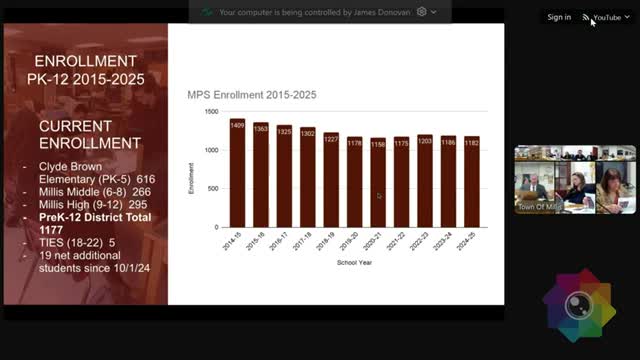Millis schools foresee potential enrollment surge amid housing developments
March 20, 2025 | Town of Millis, Norfolk County, Massachusetts
This article was created by AI summarizing key points discussed. AI makes mistakes, so for full details and context, please refer to the video of the full meeting. Please report any errors so we can fix them. Report an error »

In the heart of Millis, Massachusetts, the Finance Committee convened on March 19, 2025, to discuss pressing issues surrounding the town's school enrollment and future projections. As the meeting unfolded, committee members examined the current student population, which stands at 1,183, a figure that remains consistent with last year's numbers. This stability, however, masks underlying concerns about future growth and its implications for local schools.
The discussion highlighted enrollment figures across various educational levels: 620 students at Clyde Brown Elementary, 267 at the middle school, and 296 at the high school. Notably, the committee referenced projections from the New England School Development Council (NESDAC), which forecasted a slight dip in enrollment for the current year, estimating 1,166 students. This discrepancy raises questions about the accuracy of future projections, particularly as the town anticipates new housing developments that could significantly alter the demographic landscape.
Chief Barrett presented data on potential housing units slated for construction in Millis, suggesting that these developments could introduce between 400 to 800 new students into the school system over the next few years. While this projection is deemed "unscientific," it underscores the urgency for the committee to consider how such growth could impact school resources and infrastructure. The committee acknowledged that while the immediate fiscal year 2026 budget may not be affected, the long-term implications of increased enrollment cannot be overlooked.
Concerns were voiced regarding the adequacy of current school facilities to accommodate future growth. Clyde Brown Elementary, for instance, is already operating at near capacity, with discussions about the possibility of expanding the building to meet rising demands. The committee members reflected on historical trends, noting that past surges in enrollment have often led to overcrowded classrooms and the need for additional resources.
As the meeting progressed, the conversation shifted to the nature of early education in Millis. While pre-kindergarten and kindergarten are not mandated by state law, the committee recognized their importance in shaping future enrollment trends. The current pre-k program serves 52 students across two classrooms, but fluctuations in enrollment can lead to challenges in resource allocation.
In conclusion, the Finance Committee's meeting illuminated the delicate balance Millis must strike between managing current educational needs and preparing for an uncertain future. With housing developments on the horizon and fluctuating enrollment figures, the town faces a pivotal moment that could redefine its educational landscape for years to come. As the committee continues to navigate these challenges, the community watches closely, eager to see how Millis will adapt to the evolving needs of its students.
The discussion highlighted enrollment figures across various educational levels: 620 students at Clyde Brown Elementary, 267 at the middle school, and 296 at the high school. Notably, the committee referenced projections from the New England School Development Council (NESDAC), which forecasted a slight dip in enrollment for the current year, estimating 1,166 students. This discrepancy raises questions about the accuracy of future projections, particularly as the town anticipates new housing developments that could significantly alter the demographic landscape.
Chief Barrett presented data on potential housing units slated for construction in Millis, suggesting that these developments could introduce between 400 to 800 new students into the school system over the next few years. While this projection is deemed "unscientific," it underscores the urgency for the committee to consider how such growth could impact school resources and infrastructure. The committee acknowledged that while the immediate fiscal year 2026 budget may not be affected, the long-term implications of increased enrollment cannot be overlooked.
Concerns were voiced regarding the adequacy of current school facilities to accommodate future growth. Clyde Brown Elementary, for instance, is already operating at near capacity, with discussions about the possibility of expanding the building to meet rising demands. The committee members reflected on historical trends, noting that past surges in enrollment have often led to overcrowded classrooms and the need for additional resources.
As the meeting progressed, the conversation shifted to the nature of early education in Millis. While pre-kindergarten and kindergarten are not mandated by state law, the committee recognized their importance in shaping future enrollment trends. The current pre-k program serves 52 students across two classrooms, but fluctuations in enrollment can lead to challenges in resource allocation.
In conclusion, the Finance Committee's meeting illuminated the delicate balance Millis must strike between managing current educational needs and preparing for an uncertain future. With housing developments on the horizon and fluctuating enrollment figures, the town faces a pivotal moment that could redefine its educational landscape for years to come. As the committee continues to navigate these challenges, the community watches closely, eager to see how Millis will adapt to the evolving needs of its students.
View full meeting
This article is based on a recent meeting—watch the full video and explore the complete transcript for deeper insights into the discussion.
View full meeting
